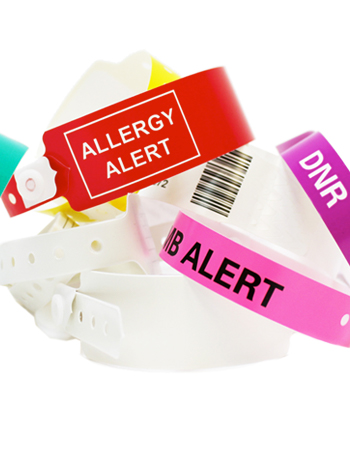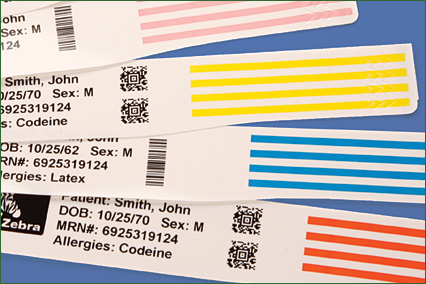Why Healthcare Facilities Pick Patient Identification Band for Efficient Patient Tracking
Why Healthcare Facilities Pick Patient Identification Band for Efficient Patient Tracking
Blog Article
Enhancing Security: The Value of Client Recognition Bands in Medical Care
In the world of medical care, the effectiveness of client identification bands can not be overemphasized, as they serve as a fundamental guard versus misidentification and subsequent errors. As we explore the complex role of these bands, it comes to be evident that their value prolongs past simple identification, elevating inquiries regarding finest techniques and future developments in patient safety and security.
Summary of Patient Identification Bands
Individual identification bands play an essential role in guaranteeing the security and accuracy of individual treatment in health care settings. These bands, generally used on the wrist or ankle, function as an essential device for verifying individual identification, therefore reducing the threat of errors in therapy, medication management, and various other health care procedures. Made from long lasting materials, person identification bands usually include essential details such as the individual's name, date of birth, medical document number, and barcodes or QR codes for scanning.
The implementation of person identification bands is crucial in numerous health care settings, consisting of healthcare facilities, outpatient centers, and lasting treatment organizations. They add to a methodical strategy in patient administration, making it possible for medical care professionals to quickly and accurately determine people, especially in high-pressure circumstances where speedy decision-making is important.
Moreover, making use of these bands is lined up with governing criteria intended at boosting person safety - Patient Identification Band. By guaranteeing that each individual's details is conveniently obtainable and conveniently proven, medical care companies can preserve a high standard of care, lower the occurrence of negative events, and promote a culture of safety within health care organizations
Benefits of Accurate Recognition
Accurate identification is basic to improving client security and care quality in medical care setups. It acts as the first line of protection versus errors that might bring about damaging patient outcomes. By ensuring that each person is appropriately determined through trustworthy ways, such as patient identification bands, medical care carriers can substantially reduce the risk of misidentification, which can bring about unacceptable therapies, medicine mistakes, and also medical mix-ups.
Furthermore, precise patient recognition helps with efficient communication among medical care teams. When all personnel can consistently identify individuals, they can share vital details more effectively, causing better sychronisation of care. This is especially vital in emergency circumstances where prompt treatments are vital.
Additionally, accurate identification sustains conformity with regulatory requirements, therefore lowering the danger of legal consequences for medical care facilities. It fosters depend on in between individuals and doctor, as clients really feel extra protected recognizing that their identities are being protected.

Usual Difficulties Faced
Guaranteeing efficient patient identification in medical care setups offers an array of challenges that can jeopardize safety and care top Continue quality. Patients may get here in a state of confusion or distress, making precise recognition difficult.
One more difficulty is the dependence on human aspects in recognition procedures. Healthcare experts might inadvertently forget or misinterpret identification procedures, particularly in high-stress atmospheres such as emergency divisions. This can bring about errors, including the administration of incorrect treatments or medicines.
Technical concerns also position difficulties. Although electronic health record (EHR) systems are developed to improve client identification, system blackouts or user errors can interfere with the procedure. In addition, the physical layout of client ID bands can result in readability concerns, particularly in situations where bands are damaged or covered.
Finally, inconsistent training among staff regarding recognition methods can lead to gaps in expertise and method. Attending to these difficulties is vital for improving client safety and guaranteeing that identification bands serve their intended objective effectively.
Ideal Practices for Execution
To properly carry out individual identification bands in healthcare setups, organizations should take on a multifaceted technique that prioritizes innovation, training, and standardization assimilation. Standardization includes establishing clear procedures for the layout, application, and use of recognition bands across all divisions. This guarantees consistency and decreases the risk of errors connected to variations in band kinds or labeling techniques.


Training is crucial for all health care team to guarantee they comprehend the value of exact person recognition, how to appropriately use and review identification bands, and the procedures to follow in instance of discrepancies. Routine workshops and correspondence course can enhance this understanding and promote a society of safety and security.
Innovation integration plays an essential duty in improving the performance of individual identification bands. Making use of barcode scanning or RFID technology can simplify the recognition process, permitting real-time verification of patient identities. In addition, electronic health and wellness record systems must be configured to consist of alerts for mismatches in between the recognition link band and person information.
Future Trends in Person Safety
As health care remains to advance, the focus on patient safety and security is most likely to heighten, driven by advancements in innovation and a greater understanding of systemic dangers. Arising trends suggest a change in the direction of more incorporated systems that leverage information analytics, man-made intelligence, and artificial intelligence to enhance client recognition processes. These modern technologies can assist recognize possible safety problems before they escalate, thus lowering mistakes related to misidentification.
Moreover, the execution of blockchain technology may transform how patient data is securely shared amongst medical care service providers, making sure that identification bands are consistently accurate and current. This will certainly not just boost patient safety but also assist in smooth communication across multidisciplinary groups.

On top of that, the growing concentrate on individualized medicine is expected to affect individual security protocols. By including group and hereditary information right into recognition systems, medical care professionals can tailor treatments better, lessening the threats of adverse reactions as a result of misidentification.
Conclusion
In final thought, client recognition bands serve as a vital part in improving safety within medical care atmospheres. Inevitably, the ongoing focus on robust identification procedures will add to improved individual end results and general security in healthcare settings.
In the world of health care, the effectiveness of patient recognition bands can not be overemphasized, as they serve as a fundamental guard versus misidentification and subsequent errors.Client identification bands play an important role in guaranteeing the security and accuracy of client treatment in health care settings. Made from sturdy products, person identification bands commonly include crucial details such as the patient's name, date of birth, clinical document number, and barcodes or QR codes for scanning.
By ensuring that each client is correctly identified through dependable ways, such as patient recognition bands, healthcare providers can dramatically decrease the risk of misidentification, which can lead to unacceptable treatments, drug errors, and also medical mix-ups.
In final thought, client visit the site identification bands offer as a vital element in boosting safety within healthcare atmospheres. Patient Identification Band.
Report this page